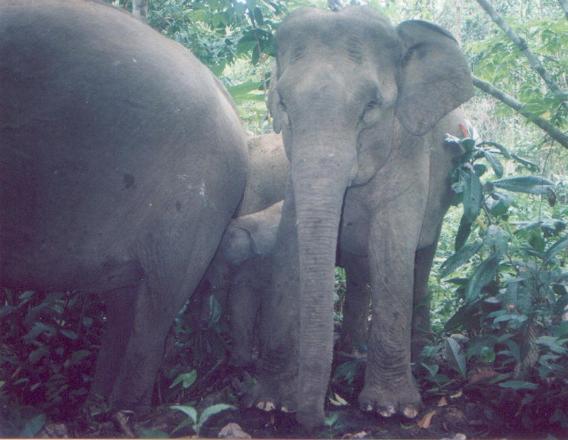It’s safe to say that the humble camera trap has revolutionized wildlife conservation. This simple contraption—an automated digital camera that takes a flash photo whenever an animal triggers an infrared sensor—has allowed scientists to collect photographic evidence of rarely seen, and often globally endangered species, with little expense and relative ease—at least compared to tromping through tropical forests and swamps looking for endangered rhino scat. Now researchers with the Wildlife Conservation Society (WCS) and the Zoological Society of London (ZSL) are taking the utility of the camera trap one step further: a study in Animal Conservation uses a novel methodology, entitled the Wildlife Picture Index (WPI), to analyze population trends of 26 species in Bukit Barisan Selatan National Park on the Indonesian island of Sumatra. While the study found a bleak decline in species, it shows the potential of camera traps for moving conservation forward since it marks the first time researchers have used camera traps to analyze long-term population trends of multiple species.
“The Wildlife Picture Index is an effective tool in monitoring trends in wildlife diversity that previously could only be roughly estimated,” the study’s lead author, Tim O’Brien of WCS, said in a press release. “This new methodology will help conservationists determine where to focus their efforts to help stem the tide of biodiversity loss over broad landscapes.”
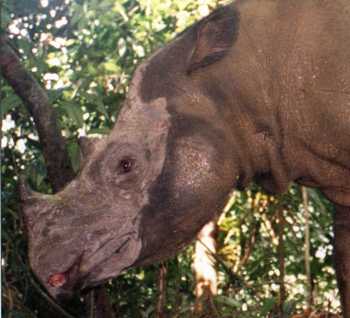 Close-up of Sumatran rhino caught on a camera trap in Bukit Barisan Selatan National Park. The Sumatran rhino (Dicerorhinus sumatrensis) is on the edge of extinction: it is believed that less than 250 individuals survive in the wild. The species, the world’s smallest rhino, is listed as Critically Endangered by the IUCN Red List and threatened by widespread deforestation, poaching for its horns, and now the simple fact that there are so few rhinos that finding another to breed with becomes difficult. Photo courtesy of WCS. |
Gathering 8 years of over 5,000 camera trap photos from Bukit Barisan Selatan National Park, O’Brien and his colleagues analyzed population trends of 25 mammals and one ground bird. They found that biodiversity suffered a total decline of 36 percent in the protected area, a loss which actually outpaced deforestation in the area.
Species sought for the lucrative black market, such as tigers, rhinos, and elephants, fell faster than smaller ones like monkeys and deer, which are killed for food or as agricultural pests. Species that had no economic value showed little change in abundance.
The researchers argue that this method, the WPI, could aid the goals of the internationally-recognized Convention on Biological Diversity (CBD), which by nearly all accounts has not succeeded in its goal of stemming global biodiversity loss by this year. The WPI may help provide better baseline of data for biodiversity worldwide, especially in the tropics where such data is often lacking.
“The Wildlife Picture Index will allow conservationists to accurately measure biodiversity in areas that previously have been either too expensive, or logistically prohibitive. We believe that this new methodology will be able to fill critical gaps in knowledge of wildlife diversity while providing much-needed baseline data to assess success or failure in places where we work,” John Robinson, WCS Executive Vice President for Conservation and Science, says.
Another positive aspect of camera trap photos is that they allow the public to peek at rarely seen animals in their natural habitats, hopefully instilling deeper interest in and concern for the world’s embattled and shrinking wildlife.
CITATION: T. G. O’Brien, J. E. M. Baillie, L. Krueger & M. Cuke. The Wildlife Picture Index: monitoring top trophic levels. Animal Conservation (2010) 1–9 c_2010. doi:10.1111/j.1469-1795.2010.00357.x.
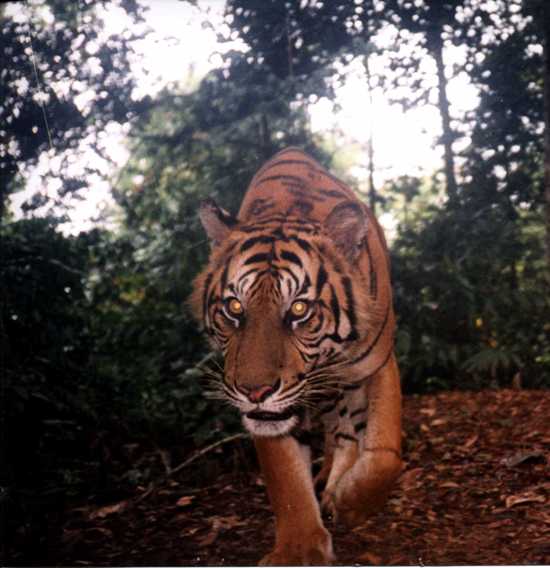
A Sumatran tiger caught on camera trap. Sumatran tigers (Panthera tigris sumatrae), a subspecies of the tiger, is listed as Critically Endangered by the IUCN Red List. Like the Sumatran rhino, tigers on the island face surviving in ever smaller patches of forest and poaching for their bones used in traditional Chinese medicine. Photo courtesy of WCS.
Sumatran elephants captured by a camera trap. The Sumatran elephant (Elephas maximus sumatranus) is a subspecies of the Asian elephant which is considered Endangered by the IUCN Red List. This subspecies is endemic to the island of Sumatra and is also threatened by poaching and deforestation. Photo courtesy of WCS.
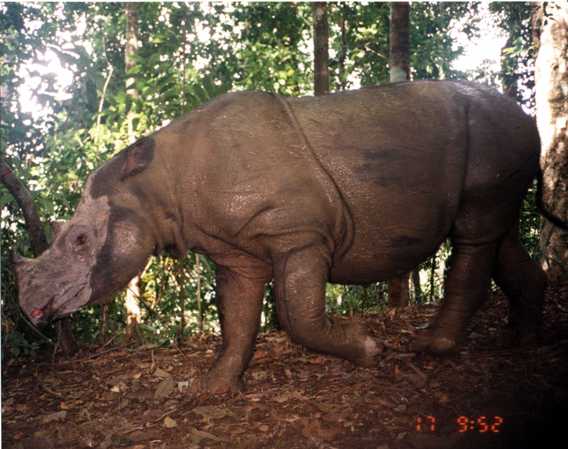
Full photo of the Critically Endangered and incredibly elusive Sumatran rhino, one of the world’s most imperiled large mammals. The conservation organization EDGE which identifies species according to their evolutionary uniqueness and global endangerment lists the Sumatran rhino as number six of the world mammals. Photo courtesy of WCS.
Related articles
Endangered otter rediscovered in Borneo
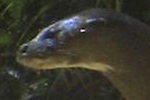
(07/25/2010) The last time the hairy-nosed otter (Lutra sumatrana) was seen in Borneo it was road-kill, but researchers have now photographed a living individual of this elusive and endangered species. Photos were taken by camera trap in the Dermakot forest in Sabah, a state of Malaysian Borneo. While the last specimen known in Borneo was killed by a car in 1997, the species hasn’t been found confirmed in Sabah for over a century.
Photos: highest diversity of cats in the world discovered in threatened forest of India
(02/18/2010) Using camera traps over a two year period wildlife biologist Kashmira Kakati has discovered seven species of wild cats living in the same forest: the Jeypore-Dehing lowland forests in the northeastern Indian state of Assam. Yet the cat-crazy ecosystem is currently threatened by deforestation, unsustainable extractive industries, including crude oil and coal, and big hydroelectric projects. Some of the cats are also imperiled by poachers. In light of this discovery, conservationists are calling on the Indian government to protect the vulnerable forest system.
Face-to-face with what may be the last of the world’s smallest rhino, the Bornean rhinoceros
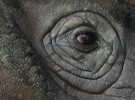
(12/01/2009) Nothing can really prepare a person for coming face-to-face with what may be the last of a species. I had known for a week that I would be fortunate enough to meet Tam. I’d heard stories of his gentle demeanor, discussed his current situation with experts, and read everything I could find about this surprising individual. But still, walking up to the pen where Tam stood contentedly pulling leaves from the hands of a local ranger, hearing him snort and whistle, watching as he rattled the bars with his blunted horn, I felt like I was walking into a place I wasn’t meant to be. As though I was treading on his, Tam’s space: entering into a cool deep forest where mud wallows and shadows still linger. This was Tam’s world; or at least it should be.
Photos: snow leopard in Afghanistan

(08/31/2009) Using camera traps, the Wildlife Conservation Society (WCS) has captured the elusive and rare snow leopard on film in Afghanistan for a second time. The feline was caught on film in the Sast Valley in Afghanistan’s Wakhan Corridor. The snow leopard is currently listed as Endangered by the IUCN. The cat is also listed as protected under Afghanistan’s new endangered species list, which outlaws hunting it. The IUCN estimates that only 100-200 snow leopards still survive in Afghanistan.
Photos: camera traps capture snow leopards in Afghanistan
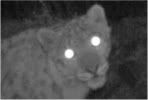
(06/09/2009) It has been estimated that Afghanistan only has 100 snow leopards left, however photos from camera traps placed by the Wildlife Conservation Society (WCS) show that there may be hope for snow leopards in the war-torn nation after all. Working in Afghanistan’s Wakhan Corridor, WCS set up five camera traps. Four of the five camera traps took photos of snow leopards, including 22 images in total.
First-ever photo of jaguar on Barro Colorado Island

(05/04/2009) Researchers have captured the first-ever photo of a jaguar on Barro Colorado Island, a key tropical forest research site in Panama, reports the Smithsonian Tropical Research Institute (STRI). The picture was snapped by a camera trap set up by Montclair State University zoologist Jackie Willis and her husband Greg. The pair have been using the traps — which use infrared to detect and photograph passing wildlife — for animal surveys on Barro Colorado since 1994.
Camera trap photos reveal bushmeat hunting threat to jaguars in Ecuador
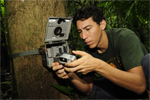
(01/27/2009) Jaguars are the largest cats of the Americas and third largest cats in the world. The primary rainforest in the Amazon region of Ecuador is among their last remaining strongholds. Jaguars are listed as “vulnerable” in Ecuador, and Santiago Espinosa, Wildlife Conservation Society (WCS) fellow, PhD candidate from University of Florida/Gainesville, and WWF fellow, wants to know just how many jaguars are left in his home country. He is developing strategies to protect them by determining their numbers and the factors that threaten them through a unique method of non-invasive photography.
Rare okapi photographed for the first time in Congo park
(09/10/2008) A camera trap has captured the first-ever photo of an okapi in the Democratic Republic of Congo’s Virunga National Park. The picture shows that the elusive forest giraffe has managed to survive more than a decade of war in and around the park.
Eight individuals of one of the world’s rarest cats caught on film
(05/09/2008) Recent photographs have brought hope to conservationists regarding the world’s rarest large cat, the Amur leopard. They were taken in the Primorisky Region of Russia by a camera trap.
